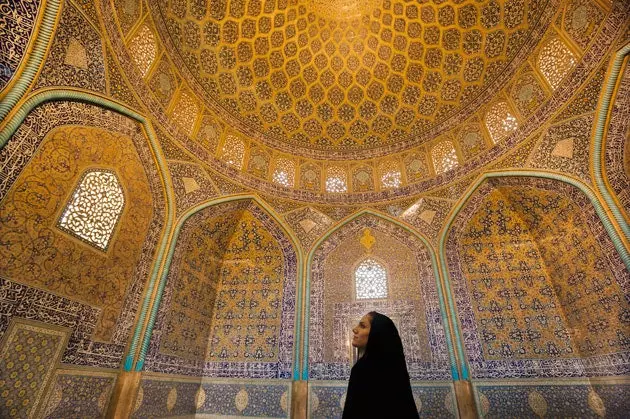
Sheikh Lotfollah Mosque
Drunk with poetry after our visit to Shiraz and a little dazed by the weight of history after Persepolis, we continue our journey through ancient Persia to find Isfahan, a city of almost mystical beauty full of vibrant souks, exquisite mosques, manicured gardens and where, above all, you will find what is surely the most beautiful square in the East, Naqsh-e Jahan. We tell you the 7 experiences to get the most out of this impressive city.
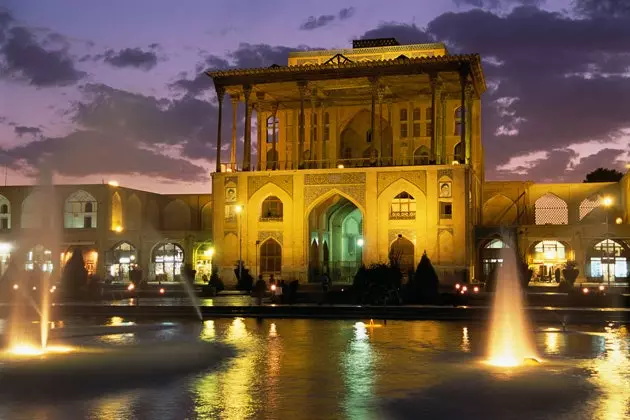
Ali Qapu Palace at night
1. MARVEL AT NAQSH-E JAHAN THE MOST BEAUTIFUL SQUARE IN THE WORLD?
For more than 30 years and whenever he can, Kader sits next to the mosque Masjed-e Shah , at one end of the square Naqsh-e Jahan to contemplate the fascinating spectacle of how the blue hues of its imposing buildings transform into a palette of unexpected hues as the day progresses.
“To Naqsh-e Jahan -this veteran potter tells us- you have to come in the morning to admire its greatness, at sunset to contemplate the magical light that is projected on its mosques and at night, ah! in the evening, the majesty of the illuminated buildings and the sound of water beating in the fountains makes you feel that the "Middle of the world" is truly before you.
Follow Kader's advice to discover the many facets of this 17th-century jewel, a UNESCO World Heritage Site, which boasts some of the most imposing buildings in the Muslim world: the Qeysarieh gate that opens to the bustle of the Isfahan bazaar, the mosque Lotfollah , the Ali Qapu's Palace or, just to the south, the mosque Masjed-e Shah , in front of which the Namaaz-e Jom'eh, the Muslim Friday prayer, is performed.
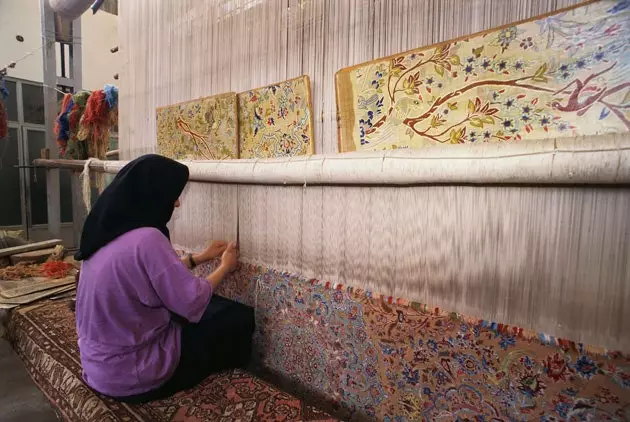
Persian rugs, a treasure
2.**KNOW THE ART OF PERSIAN CARPETS (AND MAYBE BUY ONE)**
Carpets are an essential element of Persian culture whose making has become an art of which Iranians are extremely proud. The carpet is indeed a capital issue in this Islamic Republic: there are approximately 1.2 million artisans who weave about 5 million square meters of rugs each year which are exported to more than 100 countries.
But not everything goes to the international market, an important part of that production serves to supply an important local demand. Yes, there is not a single Iranian home worth its salt where there are not at least a dozen rugs . For the living room, whose floor is literally covered, the best pieces are reserved and on them it is common for the different members of the family to settle down for meals. This is what happened to us when some friendly Isfahanis invited us to have lunch at their house. Eating the traditional lamb kebab on the rug, I couldn't help but think about the face my mother would make if she saw me in that position, she who wouldn't let us step on her beloved rugs (I doubt they were Iranian) in the living room of the house under penalty of exemplary punishment.
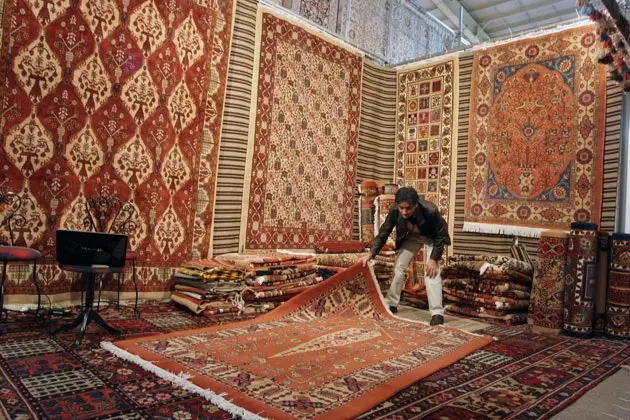
Sure you buy one...
Mandatory, therefore, an immersion in the art of Iranian carpets. In our case, we let ourselves be ambushed by a young man who approached us at the exit of a tea shop with the promise, absolutely fulfilled, of teaching us this ancient art without pressuring us to buy anything. And so, one hot afternoon in May, with a cup of tea in his hands in a huge warehouse with thousands of valuable fabric s, we learned about the technique that has made Iranian rugs famous throughout the world as well as about the different types that exist: Farsh / Qāli, (large sized rugs) Qālicheh (small rugs and the so-called Nomads, Gelim) so called for being made by itinerant tribes, usually with bright colors and a less hurried technique than that of their "older sisters".
I'm not very into rugs, but I have to admit that I almost let myself be tempted by some. "How much does this cost?" I ask. "6000 euros"-they tell me . "A little pricey, isn't it?" "Well," the solvent vendor tells me, "the most expensive Iranian rug ever sold was a 17th-century piece that cost more than $33 million in 2013." Faced with my horrified face, he calms me down to tell me that from 300 euros I can find something that isn't bad… Yeah, but I liked the 6,000 euro one!
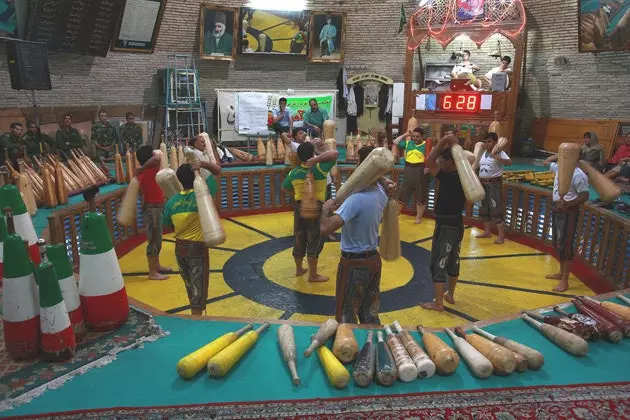
Zurkhaneh, quite a show
3. ATTEND A PAHLEVANI SHOW AT A ZURKHANEH
Sport, circus, theater and religion all in one. Zurkhaneh literally means "The House of Strength" and is the place where the so-called Pahlevani, a ritual that combines sport, religion and theater and that it takes different components from the ethical, moral and philosophical values of the Iranian civilization. Pahlevani was an ancient warrior training gymnastics known as “The sport of Heroes”.
It wasn't easy, but after questioning several locals we found a Zurkhaneh where we were invited to attend one of the training sessions. Women are not allowed access to these traditional gyms , but to me, as a foreigner, they did not raise any objections. It's 10 in the morning and a dozen very muscular men of all ages are getting ready on the circular surface of the gym. Few people attended in the stands, and we, the foreigners, received almost more looks than the fibrous athletes.
The ceremony begins and to the frantic sound of a drum the men begin to perform various exercises in perfect synchronicity. The one who seems to be the leader sings and recites verses from Iranian poets. By turns, perform juggling exercises or with weights and even, at times, they seem engaged in a kind of frenetic dance, spinning around themselves. Difficult to find a definition for this original and peculiar show that you cannot miss under any circumstances.
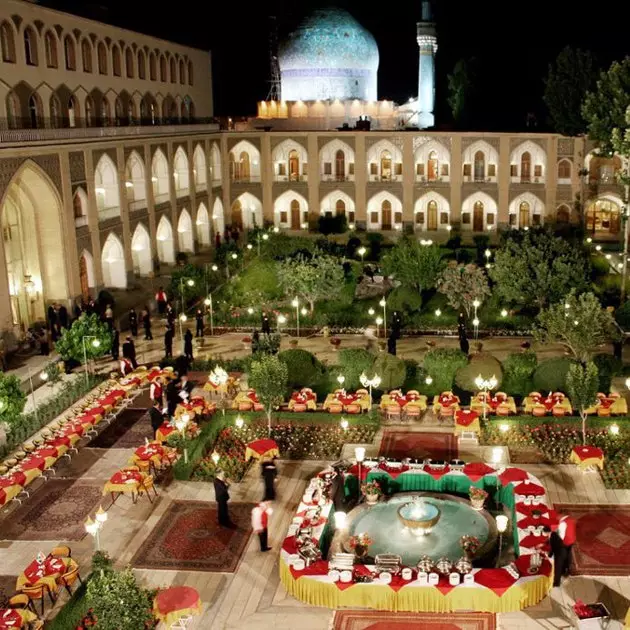
Sleep here, quite a lottery
Four. TAKE A TEA AT THE ABASSI HOTEL. OR MUCH BETTER, SLEEP THERE
I tried almost everything to get a room at Hotel Abassi, but it was impossible. More than three months before my trip, the once famous “caravanserai” (Madraseh ye Chahar Bagh) was already overcrowded. On the phone I asked the manager if he could put me on the waiting list. , to which he did not deign to answer me as if he had asked the most absurd question in the world. "But this is Iran," I said to myself, "no one is supposed to come here!"
We confirm it, there are not many tourists in this country yet but everyone seems to know the secret of Hotel Abassi, an extraordinary complex built about 300 years ago at the time of King Sultan Husayn of Safavid , an exquisite example of Persian splendor whose chandeliers and murals on the walls remind us of an opulent era of kings and princesses far removed from the veils and sobriety of the current Ayatollah regime.
If, like us, you can't stay at the Hotel Abassi, settle for having tea in its gardens. The service is worse than bad but the feeling of being in ancient Persia is priceless.
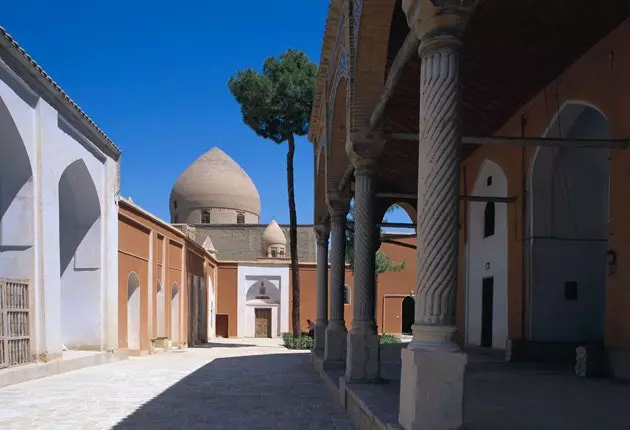
The Jolfa neighborhood, a world apart
5. DINING IN THE FASHIONABLE NEIGHBORHOOD OF JOLFA
"Not impossible. This cannot be Iran." In the Armenian quarter of Jolfa (where some 5,000 Christians still live) the stylish clothing boutiques and cafes filled with ultra-trendy youngsters they follow one another in the streets around Bank Cathedral. It is, of course, the “other Iran”, the one with i-phones, international brands and the desire to conquer more freedom.
Here they recommend us to have dinner at e the “Hermes” restaurant . The sophisticated decoration and the handsome and very modern waiters make us doubt for a moment where we really are. The girls wear the obligatory headscarf (actually, they only wear it halfway down their heads, mini-veil?), but the rest of the outfit is made up of dizzying heels, tight pants and elaborate makeup.
The food, which has little Iranian, is excellent, but even more interesting is to contemplate the spectacle around you. Safety pin. _Restaurant “Hermes” (Jolfa Alley. Nazar St. Isfahan, +98 311 629 3350) _
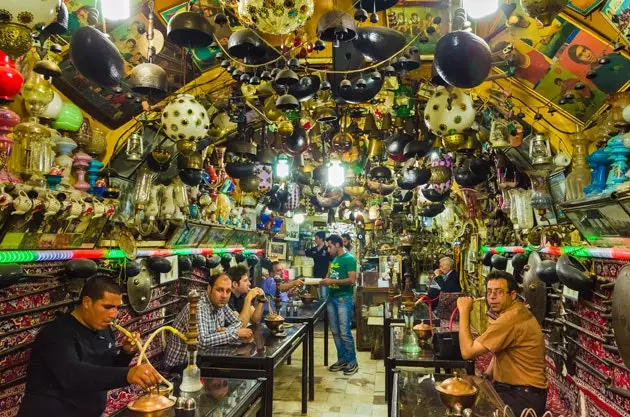
Traditional tea house in Isfahan
6. SMOKE A WATER PIPE IN A TRADITIONAL TEAPOT
Men on one side, women and families on the other. No mixing in public places following the strictest Muslim codes . But as always, a clueless person (let's say it's me) doesn't realize it and settles in the “gentlemen's” area before the astonished gaze of those who are there. There are no dramas, they kindly "repatriate" me to the women's area with the feeling, yes, of having transgressed some fundamental code.
This is what can happen to you in what is probably the most authentic Teahouse in Isfahan, the teahouse Azadegan . Hidden in an alley next to Naqsh-e Jahan square is this wonderful place, full of lamps and knickknacks hanging from the ceiling in a decadent atmosphere full of charm. Azadegan Traditional Tea house- North East of Eman Sq, tel 983112211225.
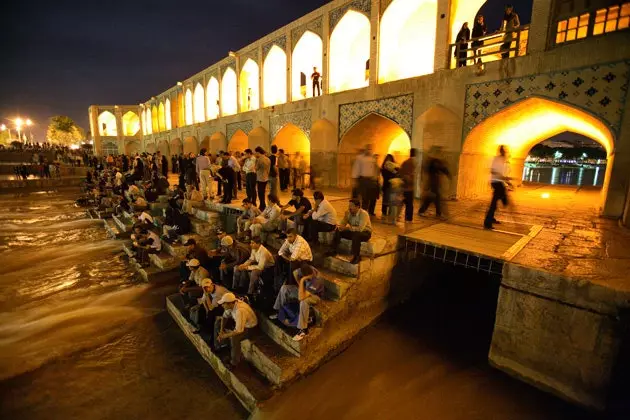
Youth by the Zalandeh River
7. WALK THROUGH THE BRIDGES OVER A WATERLESS RIVER AT SUNSET
Total 11 bridges link the two banks of the Zalandeh River (dry, very dry) that splits the city of Isfahan in two. The most impressive are the Pol-e-si-o-seh and the Pol-e-Chubi of exquisite architecture. But here, you come above all to watch the families strolling at sunset, the young people chatting in groups trying to escape from the disapproving gaze of the elders . This is the place, we are told, to “keep your eye” on a girl, or escape from the strict rules that govern Iranian social life.
_ You may also be interested in it_*
- Iran, the magic of ancient Persia
- 20 reasons to marvel at Armenia
- 10 perfect trips for a globetrotter
- Traveler Apocalypse: Endangered Places
- All articles by Ana Díaz Cano
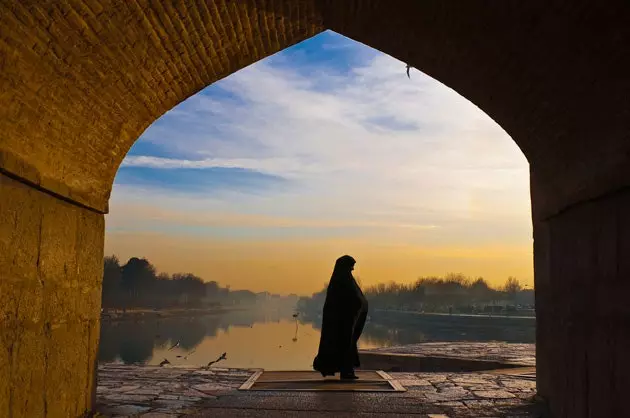
Isfahan, “Middle of the world”
